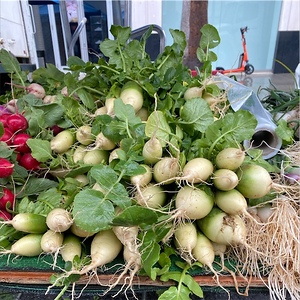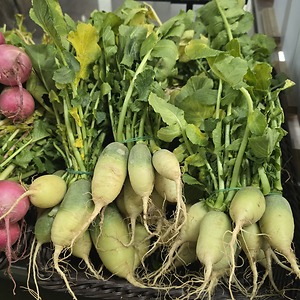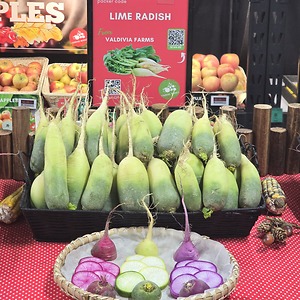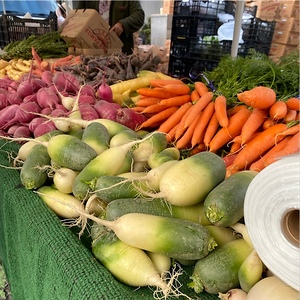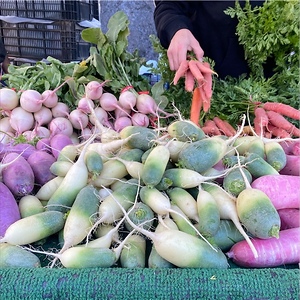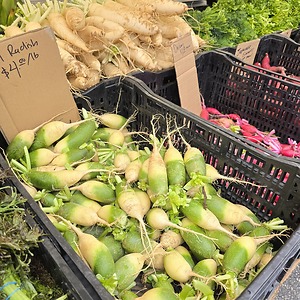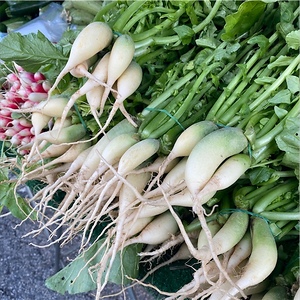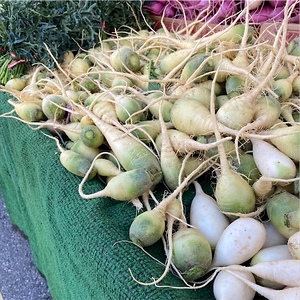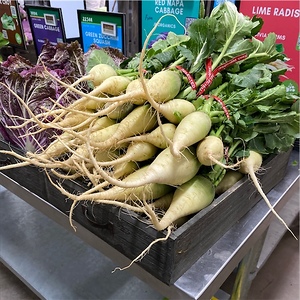


Lime Radishes
Estimated Inventory, bunch : 0
Description/Taste
Lime radishes are small to medium roots, averaging 8 to 12 centimeters in length. The radish’s skin is mostly smooth, with random areas of rougher skin and smaller hair-like roots, depending on the maturity of the radish. The root vegetable has a cylindrical and oblong shape that tapers to a point at the root end and is attached to thick, succulent stems with crisp and deeply lobed dark green leaves. Lime radishes boast bright green hues where the root connects to the greens that lighten to cream at the root end, giving an ombre effect. Underneath the surface, the flesh is dense, crisp, and bi-colored, streaked with green stripes over a white base. Immature Lime radishes have a crunchy, snap-like consistency and bear a pungent and sharp spicy flavor that permeates the nasal cavities. As the roots mature, their spicy flavor becomes milder, allowing the sweeter notes of the vegetable to shine. Once cooked, the flesh softens to a creamier consistency, and the radishes develop a more neutral flavor with sweet, nutty, and earthy notes.
Seasons/Availability
Lime radishes are available year-round, with a peak season in the spring.
Current Facts
Lime radish is the name given to the immature roots of the Green Luobo radish, botanically classified as Raphanus sativus and belonging to the Brassicaceae family. The moniker ‘Lime radish’ is a marketing name meant to highlight the radish's bright green hues and to separate them from mature green daikon, which has a milder flavor. When picked young, the roots of the radish plant are small, measuring less than 12 centimeters on average, and boast a sharp spiciness that clears the sinuses and dissipates quickly, similar to horseradish. Mature Lime radishes are also known as Green Meat radishes, Misato Green, and Chinese Green radishes. The entire plant is edible, including the leaves, flowers, and seed pods, and the roots are enjoyed in both raw and cooked applications. Green Luobo radishes have been utilized throughout Asia in culinary and medicinal practices for centuries. Recently the variety has been found under the more marketable name of Lime radish, and these roots have grown in popularity due to their unique piquant flavor and bright color.
Nutritional Value
Lime radishes contain very high levels of vitamin C, with one cup containing over 25 percent of the daily recommended value. Vitamin C is an essential micronutrient that supports the immune system, boosts collagen production, and reduces inflammation. The radishes also contain significant levels of folate to aid in the production of DNA, potassium to maintain the body’s fluid levels, and copper, a mineral that gives the body energy and supports the maintenance of connective tissues and blood vessels. The spicy roots have been used for centuries in Traditional Chinese Medicine as a digestive aid and to help clear up respiratory issues.
Applications
Lime radishes have a bright and sharply piquant flavor suited for raw, cooked, and pickled preparations. The radishes can be eaten with or without the skin, and when raw, the flesh can be thinly sliced and incorporated into salads, used as a raw vessel for dips, or chopped and mixed into slaws. The brilliant, bi-colored flesh adds visual appeal to sandwiches, appetizer plates, sashimi, and pickled preparations, or it can be coarsely grated using a special Japanese grater as a condiment. The grated daikon is known as daikon oroshi and can be added to sushi, soups, or soba noodle dishes. In addition to raw preparations, Lime radishes can be sliced into chips and fried, chopped and tossed into curries and stews, sliced and roasted for a caramelized flavor, or stir-fried with vegetables as a main dish. Beyond the roots, Purple Daikon radish leaves are edible and can be tossed into salads, sauteed as a side, or simmered into soups. Lime radishes pair well with herbs such as dill, parsley, thyme, and mint, carrots, bok choy, cabbage, mushrooms, ginger, green onions, beets, and meats, including beef, pork, duck, poultry, and fish. Whole, uncut Lime radishes will keep for 1 to 2 weeks when wrapped in newspaper or plastic and stored in the refrigerator. Once cooked, the radish pieces will keep for 3 to 7 days, and the leaves will keep up to 3 days in the fridge. Lime radishes can also be blanched and frozen for extended use for up to one month.
Ethnic/Cultural Info
In China, the tradition of pickling Luobo radishes dates back thousands of years, especially in the southern region of China known as Chongqing. Pickled radish is such a popular dish in this region that every table is expected to have a steaming bamboo bucket of rice and a bowl of pickled vegetables to be enjoyed alongside other meat and vegetable dishes. Known as Paocai, the pickled vegetables of Chongqing are made using a similar process to Korean kimchee. It is common for households in this region to have their own pot of pickled vegetables with their own spiciness and flavor. Traditionally, the pickled blend is made in a porous clay jar that can absorb the lactic bacteria that pickles the vegetables. It is believed that the quality and ‘flavor’ of the jar influences the quality and flavor of the vegetables, so quality jars are highly prized in the region. The pickling liquid used to make Paocai is also unique to each household, with recipes being well-kept secrets amongst family members, however, some commonly used spices are star anise, dried chilis, ginger, and the classic spice of Chongqing, the Szechuan peppercorn. The region's obsession with pickled vegetables often leads to interesting superstitions like not allowing visitors to touch the vegetables for fear that the oils of their skin could affect the finished product. The vegetables used vary as well from household to household and from season to season. This has to do with availability but also with the importance of food balancing in Traditional Chinese Medicine. It is believed that eating spicy pickled radish will sweat the sickness out of someone and bring back total health.
Geography/History
Lime radishes are an heirloom radish variety, also known as green meat radishes, descended from the wild radishes that still grow throughout China and other parts of Asia. Experts believe green meat radishes to be native to Northern China, where they have been cultivated for thousands of years. The first written accounts of radishes with green hues were documented in texts from around 2,000 BCE, and over time, these radishes were incorporated into medicinal and culinary practices across China. The roots were also spread along trade routes into Korea and then Japan. The radishes were spread into Eastern Europe by the 13th century and into England by the 16th century. Green meat radishes thrived in colder climates and stored well during the winter months, later brought to North America by European colonists. Green radishes with the Lime moniker are relatively new to the market, only gaining popularity in the late 2010s. When grown in warmer climates and picked early, the radishes develop a spicier flavor than the larger roots traditionally used in Asian cuisines. Lime radishes can be found in farmer's markets and specialty markets in California during the spring and summer seasons. The radishes photographed above were grown in San Diego, California, by Valdivia farms.



